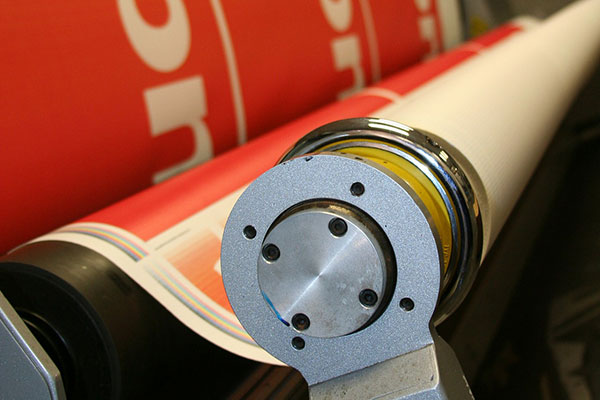Standard pigments used in commercial inks can be sensitive to many types of over print and post processing coatings. This sensitivity can result in an undesireable color shift of the printed ink, often referred to as a “bleed” or “burn-out”. Whether an ink bleeds, or the severity of the bleed, is nearly impossible to predict, however, certain basic guidelines can protect printers from experiencing this costly failure.
What causes an ink to bleed?
Some of the most commonly used pigments in the formulation of commercial inks have a poor resistance to alkali exposure. Most, if not all water based coatings are alkaline (pH 8.0 to 9.0), and alkali materials may be found in many UV/EB curable, solvent base coatings and in the adhesive for many post-processing laminates. The result of the chemical interaction between coating and pigment is a change in color of the printed ink. Reds will change to orange hues, and blues may be left colorless. This chemical reaction cannot be predicted by the pH of the coating, rather it is a specific alkali functionality that is the catalyst for this color bleed.
What colors are vulnerable to alkali exposure?
Pigments that typically exhibit sensitivity to alkali are PANTONE®:
| Rhodamine Red | Reflex Blue | Purple |
| Violet | Warm Red | 072 Blue |
| ALL Fluorescent Shades |
These colors are subject to bleeding as printed solids, however, any color made from the above bases, especially weaker pastel shades, are extremely vulnerable and have the highest probability to bleed.
How can a printer prevent a bleed if one of the above base colors must be coated inline?
Alternative alkali/bleed-resistant pigments are available as a substitute for the above colors. It is important to note that bleed-resistant pigments are not an exact match to the PANTONE® standard.
Generally, these alternative pigments are slightly weaker, and in some cases, less “clean” or slightly grayer in hue.
Why aren’t all inks made bleed resistant?
Bleed-resistant pigments are significantly more expensive (400%-500%) than standard pigments. Additionally, substitute pigments are close, but not perfect matches to the original color. Many printers choose to use bleed-resistant pigments only when in-line or off-line coatings or laminates are to be applied.
Does the substrate play a role in contributing to an ink bleed?
A highly alkaline surface pH of a stock to be printed may contribute to a sensitive color’s tendency to bleed. Also, particular care should be exercised when in-line coating jobs printing on a plastic substrate.
The non-porous nature of these substrates prevents the oxidation of alkaline-rich moisture from the pile, and, the plastic substrate itself is an efficient insulator that retains the radiated heat from the I.R. dryer. Often the pile temperature will rise to unacceptable levels (higher than 100 ° F), creating a synergistic condition that can cause even bleed-resistant inks to change color!
How long does it take to discover a pigment bleed problem?
An ink bleed may not appear for up to 24 hours after the job is printed. Bleeds are rarely uniform in appearance; they are more severe in the center of the pile and radiate towards the outer edges.
The printer’s responsibility in preventing pigment bleed.
It is critical for printers to anticipate the potential for pigment bleed with in-line aqueous coatings and off-line coatings and laminates. Inks to be used in these applications must be ordered as “bleed-resistant”. If bleed-resistant inks are not specifically requested, standard pigments will be used in the formulation, creating the potential for failure.
Please contact your Gans Technical Representative for more helpful suggestions on how to prevent costly color bleeds!


